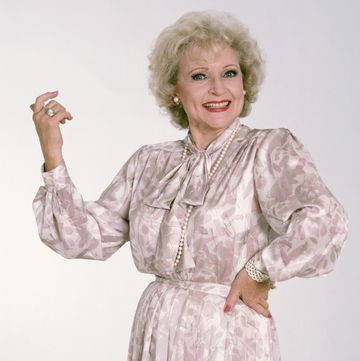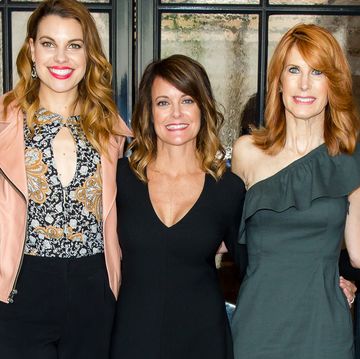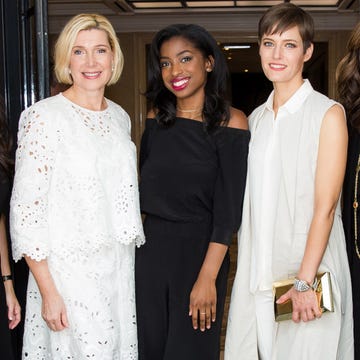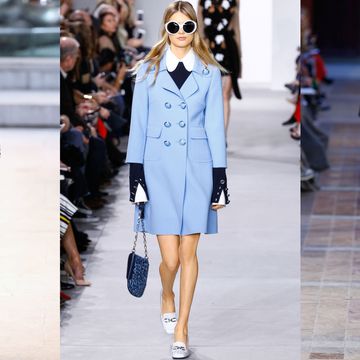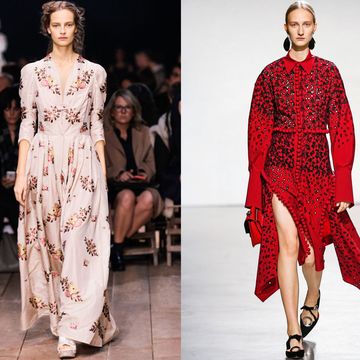Lanvin blouse, $1,255, 646-439-0380; Jill Heller Jewelry earrings, $3,500, shopBAZAAR.com. Fashion Editor: Joanna Hillman
Shirin Neshat is immediately recognizable by her signature kohl eyeliner, which she sweeps beneath each lower lid like calligraphic war paint. "I never go out in public without it," says the Iranian-born artist, 57, who is otherwise barefaced when we meet in Manhattan's Chelsea neighborhood, a black scarf wound tightly around her neck. "I go to walk my dog, and I make sure I have my eye makeup on. It gives me a sense of security."
Neshat's inclination toward self-protection comes with the territory of her work. Her haunting, dramatic photographs and video installations often depict Middle Eastern women as outsiders in their own societies, touching on third-rail issues like martyrdom and exile in a region where equality and basic civil rights for women are often still denied. In Rapture, a 1999 video installation, an army of white-clad men atop a huge fortress watches a group of women in black chadors launch a small boat into the choppy sea outside the fortress's walls. "In every video I make, the story is about female characters who are untraditional and who have a degree of madness or rebellion," says Neshat. "They embody many of my own dilemmas." Her first feature film, 2009's Women Without Men—a magical-realist tale of four Iranian women set against the CIA-backed coup d'état in the summer of 1953—took six years to make, and earned Neshat the Silver Lion award for best director at the Venice Film Festival.
Next month, the Smithsonian Institution's Hirshhorn Museum in Washington, D.C., will mount a retrospective of her work. She has also just completed an exhibition to inaugurate the Yarat Contemporary Art Centre, in Baku, Azerbaijan. The show consists of 55 massive portraits depicting a cross section of the country's population. "In ancient times, Azerbaijan was part of Iran, so we look alike," she says. "It was very emotional to go there and photograph people."
Despite the serious nature of her work, Neshat has a kittenish demeanor, and punctuates her measured sentences with soft laughter. She keeps her compact, wiry frame in fighting shape with a rigorous schedule of African dance classes at Alvin Ailey, and dresses exclusively in fitted black clothes and stacks of elaborate jewelry. "I am a very structured person, disciplined about everything," she explains. "My style and my body give me the confidence to do what I do." Neshat shares a loft in SoHo with her longtime boyfriend and fellow Iranian-American artist, Shoja Azari; they met when she cast him as a performer in her 1998 video installation Turbulent, and they often help with each other's projects. "It can be very exhilarating to work together, but it can also be very disastrous," she says, smiling. "We have learned over the years how to appeal to each other and to be patient."
Akris shirt, $795, 212-717-1170; Earrings and necklace, Neshat's own.
Hair: Peter Gray for Wella Professionals; makeup: Linda Gradin for Giorgio Armani Beauty; manicure: Tracylee for Dior Vernis; prop styling: Todd Wiggins.
Born in the northern city of Qazvin, Neshat grew up in an era when Iran embraced Western culture far more than it does today. Although her family is Muslim (she characterizes herself as secular), she attended Catholic school in Tehran because her father, a physician, wanted her to receive a Western education. At 17, she left home to study art in California and enrolled at Berkeley, only to find herself trapped in the U.S. when the 1979 Islamic Revolution made it impossible for her to return home for more than a decade. "A lot of issues in my work today go back to that time," she notes. "The sense of melancholy, the feeling of nostalgia and exile."
In the early '80s, Neshat moved to New York and married Kyong Park, the founder of Storefront, an exhibition space in downtown Manhattan. Dissatisfied with her early work (which she has since destroyed), she stopped making art and instead focused on running Storefront until 1990, when she was able to return to Iran for the first time in 12 years, her infant son, Cyrus, in tow. Fascinated by the radicalization of her former home, she began traveling there regularly, using photography and video to explore its new sociopolitical landscape. "The work made me feel grounded for the first time," she recalls. "I was returning to Iran not just geographically but emotionally." She and Park separated in 1998. "It was scary, especially because I had a child. But my work and life had completely changed, and I had to keep moving forward."
Although her mother and sisters still live in Iran, Neshat hasn't been back since 1996 because of concerns for her safety. "I've been very outspoken, so visiting is not the smartest thing to do, but I hope to go again someday," she says. "I think you have to suffer a little so that you have something to say. I'm working as hard as ever now, but I don't know where it's taking me—and that's pretty much where I was when I first started."


